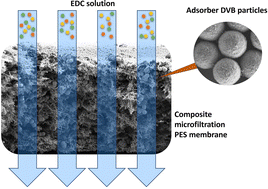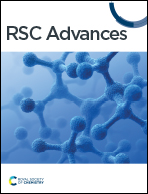Enhanced EDC removal from water through electron beam-mediated adsorber particle integration in microfiltration membranes†
Abstract
The existence of endocrine disrupting chemicals (EDCs) in water and wastewater gives rise to significant environmental concerns. Conventional treatment approaches demonstrate limited capacity for EDC removal. Thus, incorporation of advanced separation procedures becomes essential to enhance the efficiency of EDC removal. In this work, adsorber composite microfiltration polyethersulfone membranes embedded with divinyl benzene polymer particles were created. These membranes were designed for effectively removing a variety of EDCs from water. The adsorber particles were synthesized using precipitation polymerization. Subsequently, they were integrated into the membrane scaffold through a phase inversion process. The technique of electron beam irradiation was applied for the covalent immobilization of particles within the membrane scaffold. Standard characterization procedures were carried out (i.e., water permeance, contact angle, X-ray photoelectron spectroscopy and scanning electron microscopy) to gain a deep understanding of the synthesized membrane properties. Dynamic adsorption experiments demonstrated the excellent capability of the synthesized composite membranes to effectively remove EDCs from water. Particularly, among the various target molecules examined, testosterone stands out with the most remarkable enhancement, presenting an adsorption loading of 220 mg m−2. This is an impressive 26-fold increase in the adsorption when compared to the performance of the pristine membrane. Similarly, androst-4-ene-3,17-dione exhibited an 18-fold improvement in adsorption capacity in comparison to the pristine membrane. The composite membranes also exhibited significant adsorption capacities for other key compounds, including 17β-estradiol, equilin, and bisphenol-A. With the implementation of an effective regeneration procedure, the composite membranes were put to use for adsorption over three consecutive cycles without any decline in their adsorption capacity.



 Please wait while we load your content...
Please wait while we load your content...